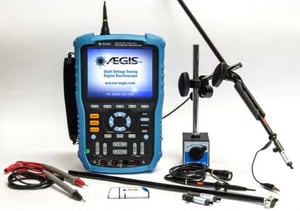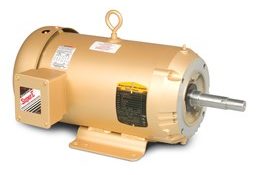Part 5 in a series of questions and answers from our Q&A webinars.
Q1: What kind of instrument do you need to test for shaft voltage?
A1: You need an ocilloscope with at least 100 MHz of bandwidth. Any brand is fine, as long as it's got the bandwidth. Sad to say, you can NOT use a multimeter or ordinary voltmeter. Shaft voltage is high frequency, & voltmeters just don't have fast enough response time.
is high frequency, & voltmeters just don't have fast enough response time.
Fluke is a great brand, and their MDA-550 includes everything you need to test for shaft voltage. But they are expensive.
Our AEGIS Shaft Voltage Tester may not have all of the bells and whistles, but it does the job. One very nice feature ours has is that you can save a reading just by pressing and holding one button. Usually you have to click through a few screens to record a reading.
Q2: We have a three foot diameter fan with a grounding ring at the fan housing. Does this offer any protection to the 250 hp motor that drives it?
A2: Absolutely. But at 250 hp, the motor is also liable to have circulating currents. You really want an insulated or a ceramic bearing to prevent those. Of course it can be hard to change the bearing on an installed motor. So you can also try common mode cores. Those will at least reduce circulating currents.
Q3: Does a motor on VFD running at constant speed have fewer problems than one with constantly varying speed?
A3: It may. Ultimately, you need to check the shaft voltage. We've seen installations that are OK running at constant speed, but we've seen plenty where they did have bearing discharge. When in doubt: Test.
Q4: Can you put a grounding ring on the non-drive end of a C-face motor?
A4: Absolutely. Sometimes you see C-face motors where there's enough room at the drive end for a grounding ring. But you can always put a ring on at the opposite drive end. The one catch is for motors over 100 hp: They will have circulating currents, and we recommend an insulated bearing at the non-drive end. The grounding ring must always be at the opposite end from the insulated bearing.
at the drive end for a grounding ring. But you can always put a ring on at the opposite drive end. The one catch is for motors over 100 hp: They will have circulating currents, and we recommend an insulated bearing at the non-drive end. The grounding ring must always be at the opposite end from the insulated bearing.
AEGIS Rings also come with a 2-year extended warranty against bearing fluting damage. No other form of protection against VFD-caused bearing damage offers a warranty like this.

To learn more about AEGIS shaft grounding and best practices for electrical bearing protection, sign up for a training. We offer monthly live training webinars, and - pandemic restrictions permitting - we can also visit your facility to review your exact application.


